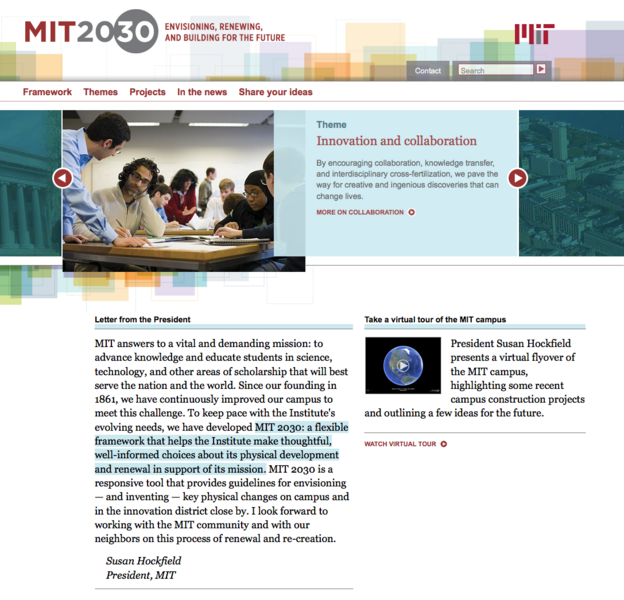This week, MIT has launched a redesigned and more comprehensive MIT 2030 website to communicate the framework for campus development and engage the MIT community in envisioning the Institute’s future. This site builds upon an earlier, informational MIT 2030 site launched last May and is the first step in a series of measures designed to increase the community engagement and participation in MIT 2030.
Israel Ruiz, MIT’s executive vice president and treasurer, describes MIT 2030 on the site as “a living framework that guides our planning activities with a focus on fulfilling the MIT mission.”
As part of MIT 2030, the site says, academic and administrative leaders are working together to envision how MIT’s campus and its surroundings could evolve to meet future academic and research needs and continue to foster innovation. The framework was designed to be flexible and responsive, providing structure without limiting the possibilities in a complex and challenging process. Its goal is ensuring that the evolution of MIT is a guided but communal endeavor.
“MIT 2030 is a responsive tool that provides guidelines for envisioning — and inventing — key physical changes on campus and in the innovation district close by,” President Susan Hockfield notes in her introductory letter on the site’s homepage.
By providing guidelines for the renovation and construction of buildings for research, academics and student life, MIT 2030 aims to further the Institute’s work to advance knowledge and educate students in science, technology and other fields to serve the nation and the world. The framework intends to align campus renewal priorities with current and future academic needs and opportunities; pursue a development approach that creates and supports an innovation ecosystem while fostering fruitful collaborations between MIT and its neighbors; and provide thoughtful guidance for the physical and financial stewardship of the Institute.
MIT 2030 is “a tool that gives us the data and the parameters to support thoughtful long-term decisions about our campus,” Associate Provost and Professor of Electrical Engineering Martin Schmidt says on the MIT 2030 site.
The MIT 2030 framework informs projects from individual systems upgrades and the repurposing of spaces and buildings to partial or complete renovations, new construction, and the best use of Institute-owned land and properties. The revamped site describes four current themes: innovation and collaboration; renovation and renewal; sustainability; and enhancement of life and learning.
Priority projects include a nano facility focused on materials research at the nanoscale (the nMaSS), considered of top importance for the schools of science and engineering. An energy and environment building is also envisioned to bring together faculty, students and researchers from the Department of Earth, Atmospheric and Planetary Sciences; the MIT Energy Initiative; and the Department of Civil and Environmental Engineering. Three renovations are also projected: Building 2 (Department of Mathematics), Building E52, and Building 50 (Walker Memorial).
The MIT 2030 website, which will be updated regularly, invites members of the MIT community to share their ideas for campus development by writing to mit2030ideas@mit.edu. Questions are welcome at mit2030info@mit.edu.
Israel Ruiz, MIT’s executive vice president and treasurer, describes MIT 2030 on the site as “a living framework that guides our planning activities with a focus on fulfilling the MIT mission.”
As part of MIT 2030, the site says, academic and administrative leaders are working together to envision how MIT’s campus and its surroundings could evolve to meet future academic and research needs and continue to foster innovation. The framework was designed to be flexible and responsive, providing structure without limiting the possibilities in a complex and challenging process. Its goal is ensuring that the evolution of MIT is a guided but communal endeavor.
“MIT 2030 is a responsive tool that provides guidelines for envisioning — and inventing — key physical changes on campus and in the innovation district close by,” President Susan Hockfield notes in her introductory letter on the site’s homepage.
By providing guidelines for the renovation and construction of buildings for research, academics and student life, MIT 2030 aims to further the Institute’s work to advance knowledge and educate students in science, technology and other fields to serve the nation and the world. The framework intends to align campus renewal priorities with current and future academic needs and opportunities; pursue a development approach that creates and supports an innovation ecosystem while fostering fruitful collaborations between MIT and its neighbors; and provide thoughtful guidance for the physical and financial stewardship of the Institute.
MIT 2030 is “a tool that gives us the data and the parameters to support thoughtful long-term decisions about our campus,” Associate Provost and Professor of Electrical Engineering Martin Schmidt says on the MIT 2030 site.
The MIT 2030 framework informs projects from individual systems upgrades and the repurposing of spaces and buildings to partial or complete renovations, new construction, and the best use of Institute-owned land and properties. The revamped site describes four current themes: innovation and collaboration; renovation and renewal; sustainability; and enhancement of life and learning.
Priority projects include a nano facility focused on materials research at the nanoscale (the nMaSS), considered of top importance for the schools of science and engineering. An energy and environment building is also envisioned to bring together faculty, students and researchers from the Department of Earth, Atmospheric and Planetary Sciences; the MIT Energy Initiative; and the Department of Civil and Environmental Engineering. Three renovations are also projected: Building 2 (Department of Mathematics), Building E52, and Building 50 (Walker Memorial).
The MIT 2030 website, which will be updated regularly, invites members of the MIT community to share their ideas for campus development by writing to mit2030ideas@mit.edu. Questions are welcome at mit2030info@mit.edu.






